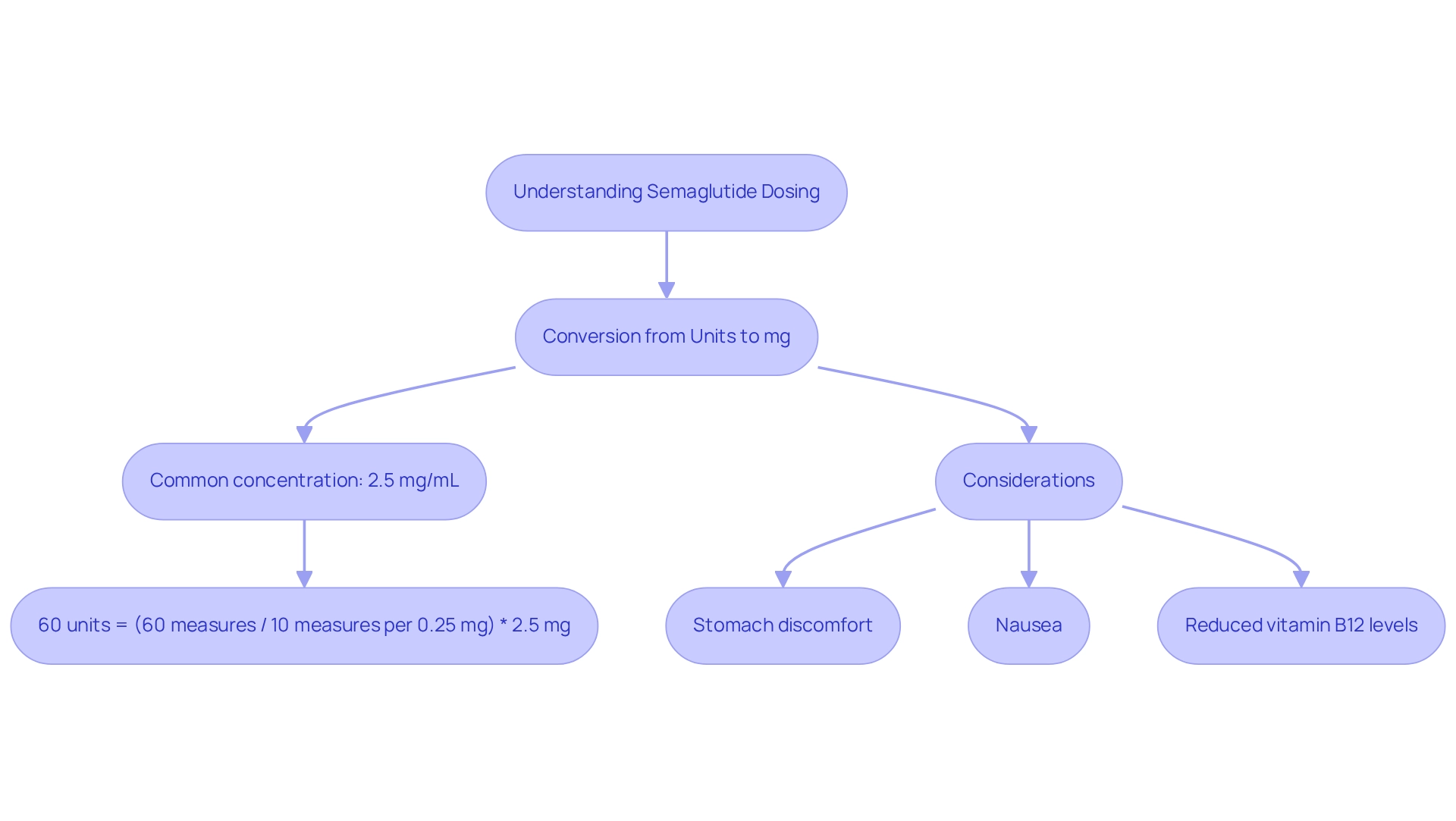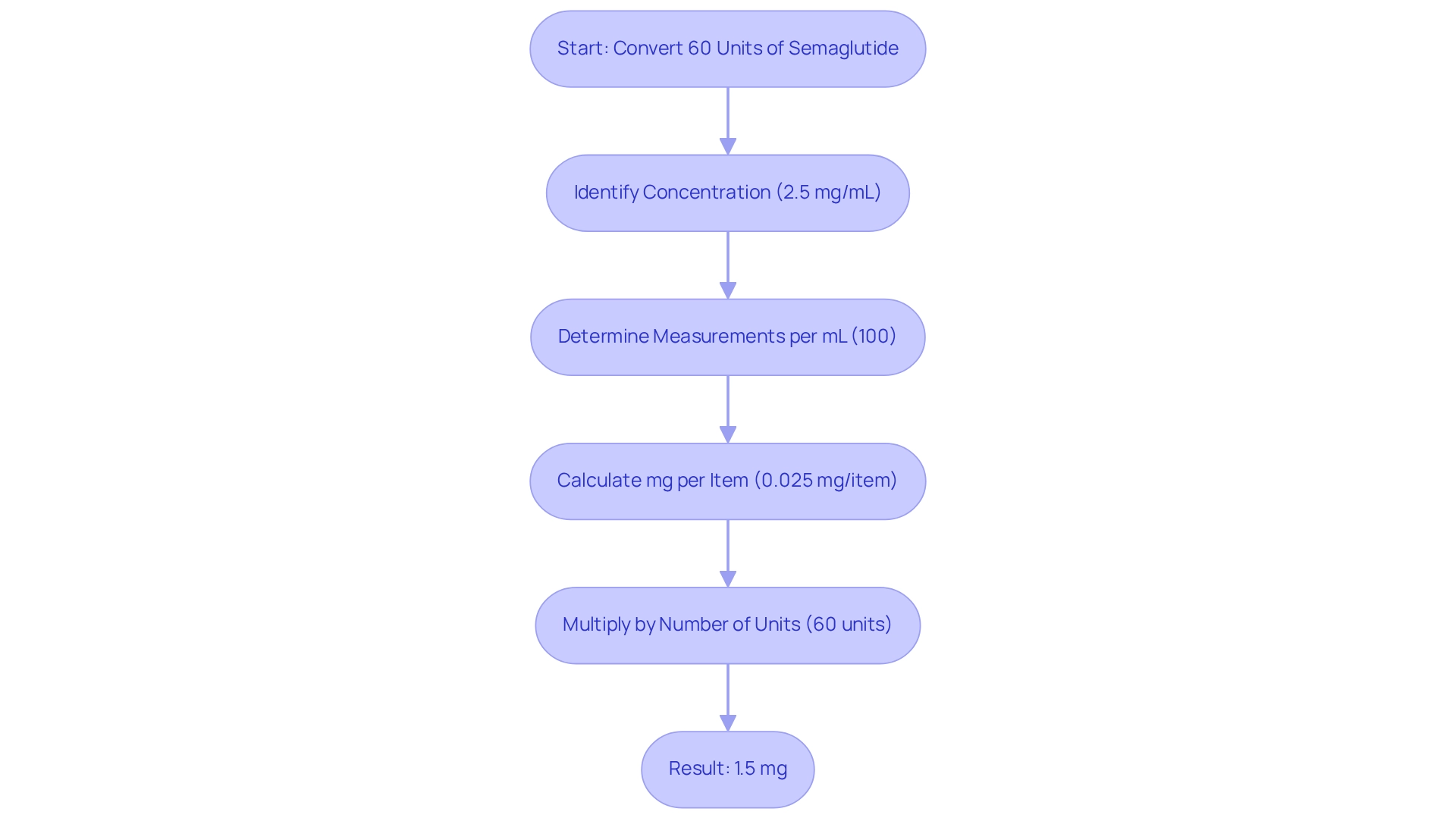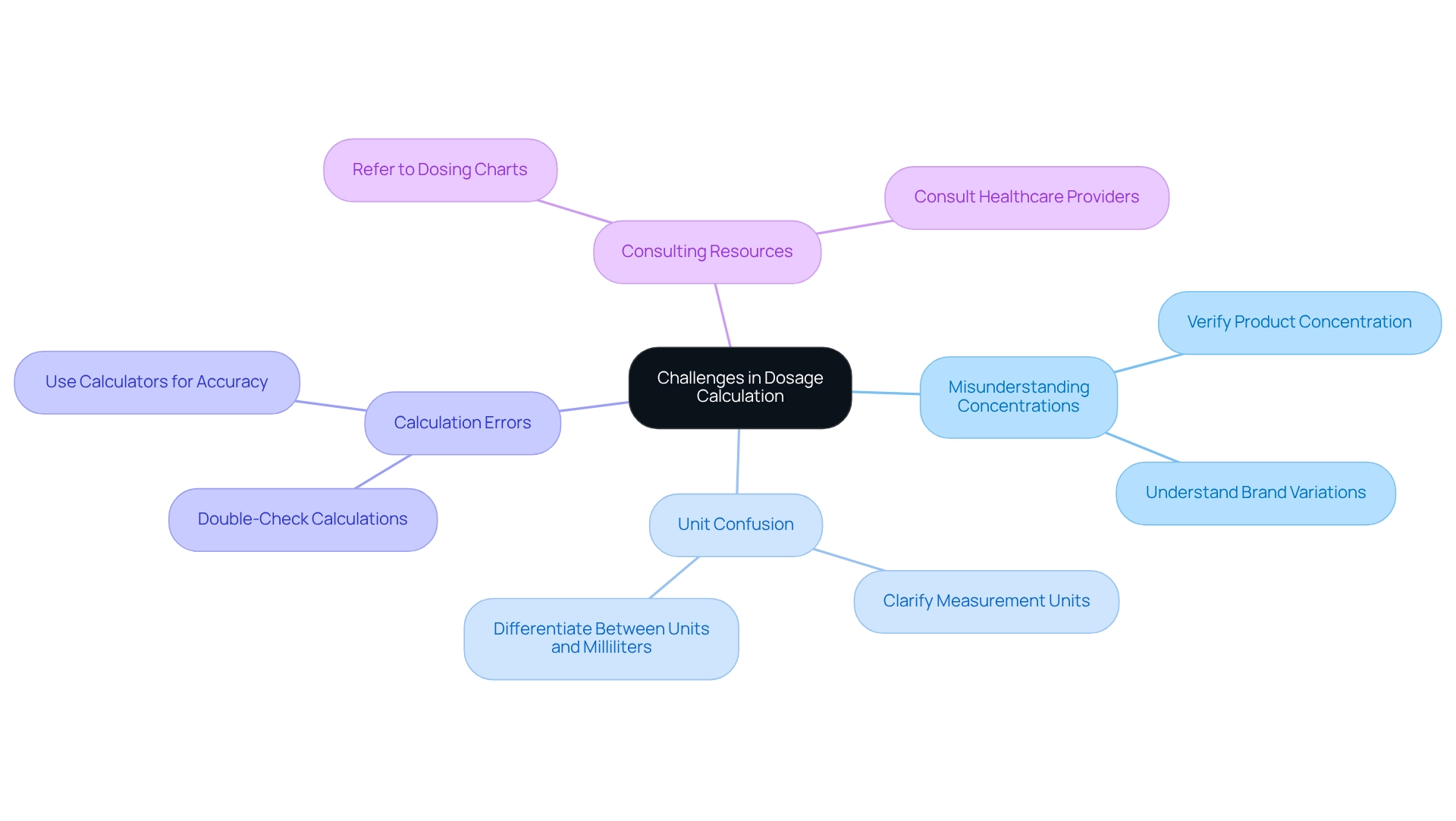Overview
Navigating your weight loss journey can feel daunting, but understanding the details can empower you. Did you know that 60 units of semaglutide corresponds to 1.5 mg when using a concentration of 2.5 mg/mL? This important information comes from a straightforward conversion process.
- First, we identify the concentration.
- Then calculate the mg per unit.
- Finally, multiply by the number of units.
Each step is crucial, as accurate dosing plays a vital role in effective weight management and diabetes control. Remember, we’re here for you, and together, we can achieve your goals.
Introduction
In the realm of modern medicine, semaglutide has emerged as a transformative ally in the management of weight and diabetes. However, we understand that its unique dosing units can often be a source of confusion for both patients and healthcare providers. It’s essential to grasp how to accurately measure and convert these units—not just for achieving optimal results, but also for ensuring safe administration. With varying concentrations across different products, navigating the path to effective treatment can feel daunting, leading to challenges such as unit confusion and calculation errors.
This article is here to help you. We will delve into the intricacies of semaglutide dosing, offering crucial insights into conversion techniques and strategies to overcome common pitfalls. Together, we can highlight the importance of precision in medication management, ensuring that you feel supported every step of the way.
Understand Semaglutide and Its Dosing Units
Semaglutide is a medication that many people find helpful for weight control and managing diabetes. It’s administered through injections, and understanding how many mg is 60 units of semaglutide is essential, as different products can vary in their concentrations.
For example, a common concentration is 2.5 mg/mL, meaning that each milliliter of the solution contains 2.5 mg of semaglutide. Typically, the dosing starts at 0.25 mg, which translates to 10 measures at this concentration, prompting the question of how many mg is 60 units of semaglutide, as this medication plays an important role in lowering blood sugar levels for those with type 2 diabetes.
It also aids in weight management by enhancing insulin sensitivity and improving long-term A1C levels for better glucose control. It’s essential to familiarize yourself with these components to ensure accurate measurement and administration of your doses, which can lead to optimal outcomes in your weight management journey.
However, it’s equally important to be aware of potential side effects, such as stomach discomfort, nausea, and reduced vitamin B12 levels with long-term use. Understanding both the benefits and considerations of semaglutide can empower you to make informed decisions about your health.
Remember, we’re here for you, and together, we can achieve your goals for a healthier life.
Convert 60 Units of Semaglutide to Milligrams
Converting 60 units of semaglutide to milligrams raises the question of how many mg is 60 units of semaglutide, which can feel a bit overwhelming, but we’re here to help you through it. First, it’s essential to know the strength of your specific product. For example, if your concentration is 2.5 mg/mL, the conversion process is straightforward:
- Identify the concentration: 2.5 mg/mL indicates that there are 2.5 mg in 1 mL.
- Determine the measurements per mL: Typically, 1 mL contains 100 measurements, although this can vary, so it’s always a good idea to check your product.
- Calculate the mg per item: Dividing 2.5 mg by 100 items gives you 0.025 mg/item.
- To find out how many mg is 60 units of semaglutide, multiply by the number of units: 60 units multiplied by 0.025 mg/unit equals 1.5 mg. Therefore, with a concentration of 2.5 mg/mL, 60 units of the medication amounts to 1.5 mg. It’s important to understand that Wegovy® not only enhances insulin production but also reduces glucose production in the liver, playing a significant role in weight loss and health management. As an FDA-approved GLP-1 injection, Wegovy® can be a valuable ally in your journey towards effective weight management and improved health.
Always refer to your medication guide or consult your healthcare provider for precise dosing instructions. And remember, to prevent irritation, it’s advisable not to inject compounded medication in the same body region more than three times. Together, we can achieve your goals and navigate this journey with confidence.
Address Common Challenges in Dosage Calculation
Determining dosages can be especially challenging for those who are unfamiliar with this medication. Let’s explore some common hurdles you might face and the strategies we can use to overcome them together:
- Misunderstanding Concentrations: It’s vital to verify the concentration of your semaglutide product, as different brands can vary. This variation significantly impacts how many mg is 60 units of semaglutide in measurements.
- Unit Confusion: Are you clear on whether you’re measuring in units or milliliters? Misinterpreting these measurements can lead to significant dosing errors, so clarity is essential.
- Calculation Errors: Always double-check your calculations. A small mistake in multiplication or division can lead to incorrect dosages. Using a calculator or dosage conversion tool can greatly enhance accuracy.
- Consulting Resources: When in doubt, don’t hesitate to refer to dosing charts or consult with a healthcare provider to confirm your calculations. Dosing charts can serve as quick references to help mitigate confusion.
By being aware of these challenges and taking proactive measures, you can significantly improve the accuracy of semaglutide dosing. It’s important to remember that pharmaceutical errors account for around 30% of injuries resulting from prescriptions in hospitals. Therefore, ensuring accurate calculations is crucial for your safety. As Steven Zauderer wisely points out, “The FDA characterizes drug errors as avoidable situations that can lead to improper use of pharmaceuticals or even damage to the patient.”
By implementing these strategies and recognizing the complexity of dosage errors, you can navigate the intricacies of semaglutide dosing with greater confidence. Additionally, studies recommend enhancing medication reconciliation processes and fostering collaboration between clinical pharmacists and healthcare providers to improve medication safety. Together, we can achieve your goals and ensure a safer journey toward your health.
Conclusion
Understanding semaglutide and its dosing units is paramount for effective weight management and diabetes treatment. This medication, often administered in units rather than milligrams, requires familiarity with its varying concentrations to ensure accurate dosing. For instance, the initial 0.25 mg dose equates to 10 units at a concentration of 2.5 mg/mL, highlighting the importance of precision in measurement. Recognizing potential side effects, such as stomach discomfort and reduced vitamin B12 levels, is equally important for a comprehensive approach to treatment.
The article also provides valuable insights into converting units to milligrams. For example, 60 units of semaglutide equals 1.5 mg at a concentration of 2.5 mg/mL. This conversion process underscores the significance of knowing the concentration of the specific product being used, ensuring accurate dosing. Furthermore, the discussion on common challenges in dosage calculation highlights the importance of understanding concentrations, avoiding unit confusion, and double-checking calculations to prevent errors that could jeopardize patient safety.
Navigating the complexities of semaglutide dosing does not have to be an overwhelming task. By being proactive in understanding dosing units, utilizing resources such as dosing charts, and consulting healthcare providers when needed, individuals can confidently manage their medication. This emphasis on precision in medication management not only contributes to achieving optimal health outcomes but also reinforces our commitment to safe and effective treatment practices. With the right knowledge and tools, we can embark on our weight management and diabetes treatment journeys together, with assurance and clarity.
Frequently Asked Questions
What is semaglutide used for?
Semaglutide is a medication that helps with weight control and managing diabetes, particularly by lowering blood sugar levels for those with type 2 diabetes.
How is semaglutide administered?
Semaglutide is administered through injections.
Why is it important to understand the conversion of units to milligrams in semaglutide?
Understanding how many mg is in different units of semaglutide is essential because different products can vary in their concentrations, which affects dosing accuracy.
What is a common concentration of semaglutide?
A common concentration of semaglutide is 2.5 mg/mL, meaning each milliliter of the solution contains 2.5 mg of semaglutide.
What is the typical starting dose of semaglutide?
The typical starting dose of semaglutide is 0.25 mg, which translates to 10 measures at a concentration of 2.5 mg/mL.
What are the benefits of semaglutide for diabetes management?
Semaglutide enhances insulin sensitivity and improves long-term A1C levels for better glucose control.
What potential side effects should be considered when using semaglutide?
Potential side effects of semaglutide include stomach discomfort, nausea, and reduced vitamin B12 levels with long-term use.
How can understanding semaglutide help in weight management and diabetes control?
Familiarizing yourself with the components of semaglutide can ensure accurate measurement and administration of doses, leading to optimal outcomes in weight management and diabetes control.




















